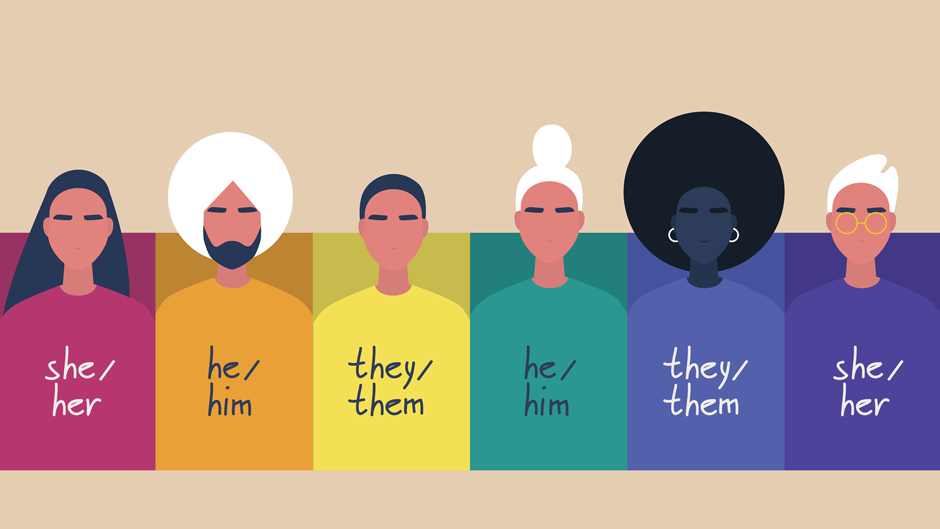Part of studying and learning a language is studying the rules of that language; the fixed guidelines for how the language operates. A second part of studying and learning a language is knowing about how the language works in practice; how people actually use the language to express their ideas, preferences and emotions. Knowing more about both of these aspects of a language is vital to being able to communicate effectively with the widest possible audience when using a language.
There has been a groundswell around the use of the traditionally plural third person pronoun they and its use as a gender-neutral substitute for the traditionally singular gendered third person pronouns she and he. When making decisions about using they, she, or he as a singular, third person pronoun, there are considerations to make about the rules of the English language as well as the way that people use the language everyday to communicate.
To review the basics, traditionally, she/her/hers and he/him/his have covered singular, gendered entities, and it/it/its covered singular non-gendered entities. They/them/their covered everything plural regardless of gender:
- The fridge at work stinks because Mary left her lunch leftovers in it all weekend.
- The fridge at work stinks because Bob left his lunch leftovers in it all weekend.
- The fridge at work stinks because it contains everyone’s leftovers from the weekend.
- The fridge at work stinks because Mary and Bob left their lunch leftovers in it all weekend.
This, of course, leads to the question of how to refer to an individual human subject or object with a pronoun if the gender identity of that human individual is unknown or irrelevant:
- The fridge at work stinks because someone left ?? lunch leftovers in it all weekend.
Historically, singular they has been in use in this context since the 14th century (Oxford English Dictionary):
- The fridge at work stinks because someone left their lunch leftovers in it all weekend.
However, the mid-18th century brought on a slew of prescriptivists who considered singular they to be ungrammatical, opting for generic he or restructuring/rewording the sentence to avoid entirely the need for a generic pronoun:
- The fridge at work stinks because someone left his lunch leftovers in it all weekend.
- The fridge at work stinks because of someone’s leftovers being in there all weekend.
In modern times, generic he has come under a lot of scrutiny, leading to discussions about inclusivity and a shift away from unnecessarily gendered pronouns (like generic he). With the intention of making writing more inclusive and accessible in such cases, prominent style guides began making a range of suggestions such as including both singular pronouns (e.g. he/she), using parentheses to combine pronouns (e.g. (s)he), or for the especially progressive at the time, leading the pair with the female pronoun (e.g. she or he):
- If someone needs to go to the hospital, he/she should probably take his/her insurance card.
- If someone needs to go to the hospital, (s)he should probably take his/her insurance card.
- If someone needs to go to the hospital, she or he should probably take her or his insurance card.
But some argued that is a lot of extra key-strokes and can become as much of a distraction to a reader as not having their (see what we did there?) pronouns acknowledged in a document.
Speakers have always had a simple, efficient solution all along (remember the note about the 14th century above?): they works just fine to describe an unknown (or even known, if you do not want to give away their identity) individual. At the English Language Institute, we maintain that the below sentences are natural, comprehensible, acceptable, inclusive, and dare we say, ‘correct’:
- The fridge at work stinks because someone left their lunch leftovers in it all weekend.
- At the beginning of the quarter a teacher should let a student know exactly how much work they will be required to do to pass the course.
Style guides have taken note of this movement towards using they/them/their as pronouns to describe individuals when the gender is unknown or irrelevant. As of 2019, the American Psychological Association (APA) included in their style guide, “The singular ‘they’ is a generic third-person singular pronoun in English. Use of the singular ‘they’ is endorsed as part of APA Style because it is inclusive of all people and helps writers avoid making assumptions about gender.” The Modern Language Association (MLA) and Chicago Manual of Style have not been as enthusiastic in advocating for the use of they/them/their as singular, gender-neutral pronouns, but have both included the usage as an option for writers in their latest updates. At this point, a writer should feel confident that they have the support of most major style guides if they chose to use they/them/their as a singular pronoun in their writing.
Another consideration to make when using they/them/their as a singular pronoun is that not only can these pronouns be used to be gender-neutral, but also to reflect a particular person’s gender identity. There are people, for example some members of the trans[gender] community, who prefer to be referred to using they/them/their pronouns not because these pronouns indicate that their gender is unknown or irrelevant, but for exactly the opposite reason. For these individuals, they/them/their is a way of having their gender identity seen and acknowledged. All of the style guides agree that knowing and respecting an individual’s pronouns when a writer is describing them is a best practice.

https://scc.losrios.edu/scc/main/img/5-Campus-Life/2-News/Featured-Images/2020/Gender-pronouns-940×529.png
Central to our values at the English Language Institute are the concepts of Empowerment, Accessibility, and Respect. Whether a writer is using pronouns to create a more gender-neutral or gender-inclusive document, they are making decisions involving feeling empowered as a writer, making their ideas accessible, and showing respect for their readers. We believe that knowledge of the rules for how English is used as well as the knowledge of how individuals actually use the language are useful for making critical decisions about how to use language in any situation. If you would like to discuss this topic further, please reach out to us in person or in the comments below; we would be happy to help you discover more resources.
We used a lot of singular they/them/their in this blog post. How many do you see?
ADDITIONAL RESOURCES/REFERENCES:
https://www.chicagomanualofstyle.org/book/ed17/part2/ch05/toc.html
https://libraries.indiana.edu/chicago-manual-style-singular-pronoun-they
https://esl.uchicago.edu/about-eli/
http://www.arrantpedantry.com/2011/10/17/they-and-the-gender-neutral-pronoun-dilemma/
https://owl.purdue.edu/owl/general_writing/grammar/pronouns/gendered_pronouns_and_singular_they.html
https://www.nytimes.com/2021/04/08/style/neopronouns-nonbinary-explainer.html
https://apastyle.apa.org/style-grammar-guidelines/grammar/singular-they

I must’ve missed it: Has there been a book burning of all the known English grammar books up until, say, 2020? You’d think that something such a profound change to society would have been widely publicized. No? No, just arrest and conviction, court hearings of those with the temerity to actually use the known rules of language, in favor of … those who refuse the bodies they were born with. Aaagh!
Hi Susan!
Singular ‘they’ for an unknown referent has actually been around since the 14th century. But yes, there are a lot of opinions regarding using singular ‘they’ for a known referent.
Weird question when using singular they. Would I say “Is that car over there theirs”? Or, would I say, “Is that car parked over there there”? Because it’s weird to not use their when if the order was reversed you would say, “Is that their car parked over there”? Not, “Is that theirs car parked over there?”
Hello Daniel, thank you for your question! So I am wondering if there may be a typo in your question. Is the actual choice between, (1a) “Is that car over there theirs?” vs. (1b) “Is that car over there their?” If yes, it might help to examine a similar case, (2a) “Is that car over there hers?” vs. (2b) “Is that car over there her?” Do you get the sense that 2a is correct, and 2b, incorrect? If yes, you can compare this to, (2c) “Is that her car over there?” vs. (2d) “Is that hers car over there?” 2c is correct, and 2d is incorrect. So the two different question frames are necessitating a grammatical shift between ‘hers’ and ‘her.’ Therefore, similarly, (1a) is correct, and this is not contradictory with the grammar of, “Is that their car over there?” I hope that makes sense!